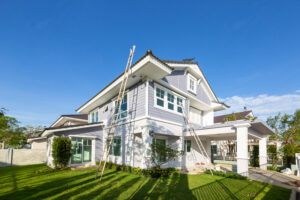
Exterior house painting is the wisest investment that makes your home look new and beautiful with minimal effort. It also protects your house from harsh and rough weather. Many people try to save some bucks by DIY painting. But professional painters are more efficient and can do the external house painting job perfectly.
It might sound like a sermon, but for a perfect exterior painting work patience, and dedication are necessary. A fine eye, firm grip, and technique are required to produce smooth and clear lines. You will need to move and arrange painting equipment like tall ladders, brushes, and boxes, etc. Trying to paint your property is a time consuming task. So we always suggest you talk to exterior house painters in your local area to skip through all the hassle. Here are some tips and tricks that you can follow and make your exterior house painting a fun experience.
How is the weather?
If your house gets pretty harsh sun, chances are your exterior paint will chip off sooner. However, color manufacturers are selling many paints that can withstand rough weather. Your exterior painting contractor can recommend the best quality color for your house.
Also, try to avoid painting in the bright sun as the color will not get enough time to settle because of the harsh light.
- You should always avoid painting in the bright sun. This heat hardens the pigment quickly; avoiding lap marks become practically impossible. It might cause cracking and peeling.
- Skip painting on particularly windy days. The wind speeds up the drying time and might sweep impurities onto the wet paint.
- If the heat is less than 50 ° F, do not use acrylic paint unless the seller has specially prepared it for winters.
- If there is rain in the forecast, do not paint.
Highest Quality Paint
We consider a hundred percent latex paint the best option for exterior house painting.
Latex paints are water-based, and as the paint dries, the water evaporates. What remains is the finished paint. It includes pigments (the color) and the binder (what keeps the pigment sticking to the wall). Naturally, the liquid with a higher volume of pigment and binder is better as it enhances sustainability.
Your local paint shop should have the information about which paint has higher volumes and is likely to withstand the harshest weather. Colors with labels such as Premium and Deluxe have more durability than other cheaper brands.
The Right Brushes
Apart from the equipment you have for scraping and priming, you will need painting brushes with high-density bristles and a comfortable grip. You can purchase a minimum of two brushes, a 4-in for regular acrylic paint and a 1-in for wider regions. Angled sash brushes come in handy for getting the details right.
Clean the surfaces
Do you want to start painting right away? Wait, this is the part they don’t show in the movies! 95% of a great exterior painting is because of a suitable surface. An ideal exterior is necessary for any wall painting to have a smooth finish.
If you are painting a house with a sandy exterior, smooth it with sandpaper and leave it for at least 20 days to get settled. Unsettled stucco will cause a gritty or dirty finish.
If you are painting an old property, check if the walls are chipped, peeled, or has mildew deposition. Remove mildew by spraying chlorine bleach with the help of a lawn sprayer.
Prepare the surfaces
Take a bottle of a sealant as you take a paintbrush. If the wall has cracks and joints, you need to fill them as one sort of painting material fuses with another. The frames of the windows, doors and skirting boards also come under this department. If the old surface has dying stucco, replace it with a fresh one and let it dry. Replace wooden sidings or panels with decaying symptoms. Smooth the wood and doors to assure the best painting surface.
The color will stick better to a smooth surface. To eliminate debris, grime and sand, use a water hose. Go from high to low and cover every line.
Make friends with the Primer
Use a premium sealer for priming to get the best results from your paintwork. The Sealer has a lot of resin that engulfs the old paint and prepares a perfect surface for fresh paint.
For a chalky wall, select a chalky or dusty sealer. Paint does not adhere to the surface of a dusty one.
For new wooden and vinyl surfaces, acrylic primer serves well. A primer may not be necessary if your recent paint is similar or darker than the current color. But, if you want a lighter color, you’ll have to use a primer first.
You can put the Primer using a sprayer. However, because of its thickness, you can dilute it for a better throw. See the instructions given on your primer packet to know how long you should let it stay before painting.
Make the perfect finish
You should paint wooden elements such as gates, door rims, molding, and windows last. A firm hand plus a decent brush are the best instruments for this job. To reduce efforts, use 6-inch “hot dog” brushes to paint faster, especially down the roof edge. However, there is no replacement to a pro finish; you must invest a lot of time to achieve the best results.
Depending on your climatic conditions, a good coat of paint using high-quality products can last up to ten years.
Contact the Professionals for Exterior House Painting
Pizzazz Painting’s exterior painters have a lot of experience in all modern painting procedures. To ensure the highest quality painting, we employ the best supplies and workforce.
As you choose Pizzazz Painting contractors for painting your house, we can assure the best finish your home deserves. Contact us now for a free quote on your upcoming home or business painting project! Visit the website for further details.

